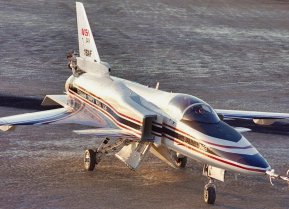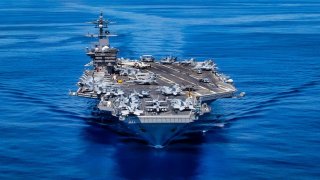China's Supercarrier Has Begun Catapult Testing
The People's Liberation Army Navy's (PLAN's) most advanced aircraft carrier has begun testing and could soon take part in the first of its sea trials – an important step before the warship can enter service.
Aircraft Carrier History for Beijing - China's Supercarrier Has Begun Catapult Testing - The People's Liberation Army Navy's (PLAN's) most advanced aircraft carrier has begun testing, and could soon take part in the first of its sea trials – an important step before the warship can enter service. According to reports, the Type 003 Fujian, which was launched last year, has moved several dozen meters from its usual berthing place at the Jiangnan shipyard in Shanghai before returning to its normal position.
Even as the 80,000-ton carrier – the PLAN's third and largest flattop – prepares for its upcoming sea trials, tests have begun on the vessel's electromagnetic catapult system. The PLAN is just the second navy after the United States Navy to adopt the technology.
The USS Gerald R. Ford (CVN-78) became the first carrier to employ an electromagnetic aircraft launch system (EMALS). It enables faster take-offs, increases energy efficiency, and puts less stress on the airframes during launches.
An electromagnetic catapult can also deploy a wider range of aircraft, including manned and unmanned systems. That can include transport aircraft, fixed-wing early-warning and control aircraft, and large drones.
Catapult Tests Begin for China's New Aircraft Carrier
It was over the weekend that the first "dead load" launch test of the Type 003's catapult system was confirmed. Images and videos of the tests were reportedly recorded from a commercial aircraft flying out of Pudong Shangai International Airport and subsequently posted to the Chinese social media platform Weibo and then on X, the service formerly known as Twitter.
The video footage showed the launch and subsequent drop of a test vehicle from one of the two forward catapult positions on the Fujian's flight deck. The test vehicle didn't actually take to the skies – as it is a "dead load," and instead it fell into the water basin forward of the ship.
Such tests are common for all catapult-equipped aircraft carriers, both during initial construction and then after major overhauls. According to Naval News, such a test was conducted following the French Navy's flagship carrier Charles de Gaulle in Toulon.
A Great Leapfrog Forward for China's Supercarrier
The Type 003 Fujian, which was launched in June 2022, is the PLAN's first carrier to be equipped with electromagnetic catapults to launch aircraft. Its other two carriers – the Type 001 Liaoning and the Type 002 Shandong – each employ ski-jump take-off ramps.
Beijing is essentially "leapfrogging" the steam catapults that are employed on the U.S. Navy's Nimitz-class carriers that first entered service in the 1970s.
"Catapulting the small vehicle itself is a step in the testing of the aircraft carrier for sea trials," Song Zhongping, a former PLA instructor, told the South China Morning Post. "I don't know if the video is real, but this is something that needs to be done eventually."
The Fujian is expected to be able to carry as many as 40 jet fighters. The PLAN's current carriers can handle 18 and 32 fighters.
J-15T Tests Coming Soon?
The 316-meter long carrier is expected to operate the PLA's J-15T, a modified version of its Shenyang J-15 "Flying Shark" (NATO reporting name "Flanker-X2"), an all-weather, twinjet, carrier-based fourth-generation[4] multirole fighter aircraft developed by the Shenyang Aircraft Corporation (SAC) and the 601 Institute, specifically for the People's Liberation Army Naval Air Force (PLANAF) to serve on People's Liberation Army Navy's aircraft carriers.
The J-15T variant can operate with catapults, unlike the original models of the aircraft that currently are employed on the PLAN's two active carriers.
At least two prototypes of the J-15T have been built, while the PLANAF has also been developing the J-15B – an improved model that incorporates CATOBAR launch capability from the J-15T, while it is also equipped with modern fifth-generation avionics, AESA radar, new airframes, stealth coatings, and compatibility to launch PL-10 and PL-15 missiles. It is reported to be flight testing.
A Carrier Superpower – But Not Second to None
Beijing has maintained that the Type 003 Fujian is on track for a planned maiden deployment in 2025.
When it enters service, China will have the second-largest number of operational aircraft carriers of any navy in the world. The United States Navy currently operates 11 nuclear-powered carriers.
Type 001 Liaoning is little more than a training carrier in terms of its capabilities. The vessel was originally built for the Soviet Navy as the Kuznetsov-class aircraft cruiser Riga. Following the collapse and dissolution of the Soviet Union in 1991, construction was halted and the unfinished vessel was put up for sale by Ukraine. The stripped hulk was purchased by a Chinese firm, reportedly to be converted into a floating hotel and casino.
Since the carrier had been left to deteriorate in the elements, it had seemed unlikely it would be used as a warship. Yet, it was eventually refurbished by the PLAN and became China's first aircraft carrier.
The Type 002 Shandong was arguably a "proof of concept" that Chinese industry could build a carrier domestically. It was still based on its predecessor. However, China is now on track to finally have a truly world-class supercarrier, one that should be seen as a potential threat to the U.S. Navy.
Author Experience and Expertise
Peter Suciu is a Michigan-based writer. He has contributed to more than four dozen magazines, newspapers, and websites with over 3,200 published pieces over a twenty-year career in journalism. He regularly writes about military hardware, firearms history, cybersecurity, politics, and international affairs. Peter is also a Contributing Writer for Forbes and Clearance Jobs. You can follow him on Twitter: @PeterSuciu.
All images are Creative Commons. The image is of a U.S. Navy Aircraft Carrier at sea.


